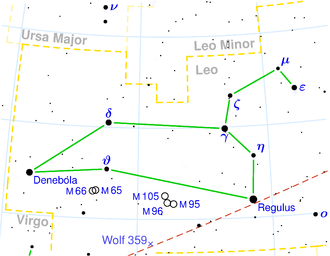IC 2520
| Galaxie IC 2520 | |
|---|---|
 | |
| SDSS-Aufnahme | |
| AladinLite | |
| Sternbild | Löwe |
| Position Äquinoktium: J2000.0, Epoche: J2000.0 | |
| Rektaszension | 09h 56m 20,1s[1] |
| Deklination | +27° 13′ 39″[1] |
| Erscheinungsbild | |
| Morphologischer Typ | Pec / HII[1] |
| Helligkeit (visuell) | 13,4 mag[2] |
| Helligkeit (B-Band) | 14,4 mag[2] |
| Winkelausdehnung | 0,7′ × 0,6′[2] |
| Positionswinkel | 90°[2] |
| Flächenhelligkeit | 12,3 mag/arcmin²[2] |
| Physikalische Daten | |
| Rotverschiebung | 0.004149 ± 0.000011[1] |
| Radialgeschwindigkeit | (1244 ± 3) km/s[1] |
| Hubbledistanz vrad / H0 | (53 ± 4) · 106 Lj (16,3 ± 1,1) Mpc [1] |
| Geschichte | |
| Entdeckung | Stéphane Javelle |
| Entdeckungsdatum | 26. März 1900 |
| Katalogbezeichnungen | |
| IC 2520 • UGC 5335 • PGC 28682 • CGCG 153-004 • MCG +05-24-003 • 2MASX J09562016+2713393 • LDCE 0686 NED003 | |
IC 2520 ist eine Galaxie vom Hubble-Typ P[2] im Sternbild Löwe am Nordsternhimmel. Sie ist schätzungsweise 53 Millionen Lichtjahre von der Milchstraße entfernt.
Das Objekt wurde am 26. März 1900 von Stéphane Javelle entdeckt.[3]
Weblinks
Einzelnachweise
Auf dieser Seite verwendete Medien
Autor/Urheber: Copyright © 2003 Torsten Bronger., Lizenz: CC BY-SA 3.0
This is a celestial map of the constellation Leo, the Lion.
Autor/Urheber: Sloan Digital Sky Survey, Lizenz: CC BY 4.0
The sky image is obtained by Sloan Digital Sky Survey, DR14 with SciServer.
Angle of view: 4' × 4' (0.3" per pixel), north is up.
Details on the image processing pipeline: https://www.sdss.org/dr14/imaging/jpg-images-on-skyserver/



